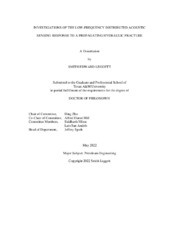| dc.description.abstract | Low-frequency distributed acoustic sensing has emerged as a significant diagnostic tool for characterizing unconventional completions. The distributed sensor is deployed on a monitor well and provides measurements of deformation due to propagating hydraulic fractures originating from offset wells. Lab-scale experiments and numerical investigations were conducted to aid in interpreting field-measured low-frequency distributed acoustic sensing responses.
Novel hydraulic fracture experiments were conducted using transparent epoxy blocks as fracture specimens. The epoxy blocks contained embedded fiber optic sensors used to record the strains induced by radial fracture growth. The results confirmed current interpretations of characteristic low-frequency distributed acoustic sensing patterns observed in the field. These patterns indicate the time and location that a fracture intersects the monitor well. The experiments also revealed the significance of sensor spatial resolution and debonding on the ability to accurately predict the timing of a fracture intersection. In addition, the zero strain and zero strain rate location methods were developed to estimate the location of the fracture front as it approached the monitor well using low-frequency distributed acoustic measurements.
As for the numerical investigations, a new equation was derived that relates changes in the low-frequency distributed acoustic response to temperature and strain. This relationship enabled simulation of thermal effects on the low-frequency distributed acoustic response during a multi-cluster, limited-entry type unconventional completion.
A workflow was presented to model fracture geometries, and estimate resulting far-field strain and temperature changes along a fiber optic cable. The results indicate that temperature changes can appreciably alter the low-frequency distributed acoustic response at a similar order of magnitude to strain changes after a fracture intersection occurs. However, temperature changes do not affect interpretations of the timing and location of the first fracture to intersect the monitor well. | |


